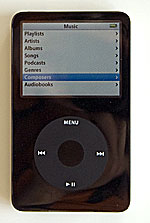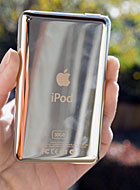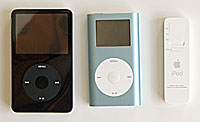|
|
|||||||
|
Apple iPod Reviews Apple iPod Video: 5G 30 and 60 gig
Reviewed Nov 28, 2005 by Lisa Gade, Editor in Chief Update: Apple has modestly revised the iPod 5th generation to the 5.5G, which comes in 30 and 80 gig capacities and features a brighter display. Let's face it, I don't have to tell you what an iPod is. Everyone from grandma to junior in the 3rd grade knows about the iPod, and you'll see them peering out of the pockets of folks on the street in Paris, Manhattan and Peoria. Apple released their 5G (5th generation) iPod line in late October 2005. That's quite a few generations of the hit portable music player, and miraculously, I, the Editor in Chief of a major mobile electronics site, took that long to succumb. "But I can play MP3's on my PDA", I said. And I watch videos on my iPAQ hx2490 and Dell Axim X51v Pocket PCs all the time (nothing better for beating long flight boredom). But 4 gig CF and SD cards are as big as it gets right now, limiting the amount of multimedia goodness you can put on your PDA. And the price of those high capacity cards approaches the cost of a 30 gig video iPod. If you've burned DVD video content for your PDA, you know it's not the easiest and most user-friendly experience. Enter Apple, famous for making things easy. And so they did, using iTunes and the iTunes store, it's brain-dead easy to get music onto your iPod, and videos too. The Apple iTunes store has music videos, a selection of TV shows and (surprise) Pixar shorts you can purchase and download to your iPod for a modest $1.99 each. Songs of course, are 99 cents each. And, like the last generation Photo iPod, it shows photos too. . . and it syncs calendar and contacts with MS Outlook. And unlike earlier generation iPods, it's not shockingly expensive. OK, I'm game!
The Basics Just in case you're a newbie, the iPod is a portable music player that's quite small and very attractive. It can play MP3 as well as AAC music along with Apple's own format used on the tunes in their iTunes store. You can burn your CDs using iTunes (or even another music burning app) in MP3 format or AAC for use in your iPod. That process is quite fast and you can generally burn an entire CD in 5 minutes or less. If you want to buy tunes, you'll need to use the extremely popular iTunes store to do so because that's the only DRM (digital rights management) format the iPod supports for copy protected music. Other commercial music download sites would like to offer iPod compatible copy protected songs, but Apple won't share information about their Fair Play DRM standard with other companies. |
Advertisement |
|||||||||||
You can get your iPod in either black or white and in 30 gig or 60 gig versions. The 30 gig will set you back $299, or double your storage to 60 gigs for $100 more. Black or white, it's your choice, though I'd recommend black if you plan to watch a lot of videos since black surrounds enhance our sense of image contrast and brightness (now you know why notebook and many TV bezels are black). While the iPod Nano gained some bad press for scratching easily, our black iPod Video, with reasonable care, hasn't succumbed to excessive scarring. The chrome-like back will show fingerprints like crazy, along with a few fine scratches, so be kind to your device if pristine looks count. The included slip case's inner surface is super-soft and is reminiscent of chamois: combine that with a snug fit and you've got something that will wipe off some of those fingerprints each time you insert and remove your player. For better protection, consider 3rd party cases which are available in many forms including silicon jackets, leather flips and arm-band holders. What's New? Video! Steve Jobs still describes the iPod as a portable music player first. Why? Because that market is well established and Apple happens to lead it both in MP3 player sales and in music downloads from the iTunes Store. Video? When the iPod 5G launched, there wasn't much video content on iTunes-- just a few music videos and TV shows. A year later, there are 250 TV shows, a growing selection of feature length films, short films and lots of music videos. Pricing is reasonable at $1.99 per TV show episode and you can purchase a season pass for a TV show and save some money. Movies run from $9.99 to $19.99 and music videos are $1.99. To make the studios happy, you'll only be able to play your videos from the iTunes store on your iPod or in iTunes on your computer: you can't burn them to a CD or DVD. TV shows are edited to remove the commercials. Video quality is very good on the iPod: smooth, bright, sharp and easy on the eyes despite the small screen. That takes some nice hardware: the iPod video has a 2.5" transflective TFT color display that's really, really nice. Having watched video on 2.8" Pocket PC Phone screens and larger portable media player screens, I had my doubts that going down to 2.5" was such a good thing. Well, it looks great and the iPod has the same 320 x 240 resolution as standard QVGA Pocket PCs. I wouldn't want to watch football or basketball on a 2.5" display (players are small as ants), but for watching short videos and even 1 hour TV episodes, it works surprisingly well. Initially, downloaded iTunes videos were in QVGA resolution but in the summer of 2006 they were all upgraded to VGA, making for a better on TV experience (should you plug your iPod into your TV to watch downloaded video content). Apple faces competition from the fledgling PMP (Portable Media Player) market. So far these devices haven't become household names or must-haves on a whole lot of Christmas lists. Microsoft's own portable Media Center devices offered by the likes of Creative and Samsung have done even more poorly since they're tied to Windows Media Center Edition PCs and don't handle video formats such as MP4, DivX or MOV. PMP's such as the PQI mPack P800 we reviewed here have larger displays, though most run at a similar resolution (QVGA) and offer similar storage capacities. The iPod has the advantage in size, existing overwhelming success as an MP3 music player, and in their downloadable videos from the iTunes store (OK, the selection on the store needs to improve, but we're betting it will). In November 2006, Microsoft released its Zune player to compete with the iPod video. You can read our review of that device here, and it's worth a look if you're looking for a new player and don't already own lots of iTunes content downloaded from Apple's store. The iPod video, like PMPs, can play homebrew and downloaded free video in MP4 and MOV (QuickTime) format along with MV4 files purchased from the iTunes store. Yes, this means you can burn DVDs to MP4 format and load them on your iPod. For you video aficionados, here are the complete specs: H.264 video: up to 768 Kbps, 320 x 240, 30 frames per
sec., Baseline Profile up to Level 1.3 with AAC-LC up to 160 Kbps, 48
Khz, stereo audio in .m4v, .mp4 and .mov file formats. You can use one of the free burners on the market and even the popular, free PSP Video 9 does the job if you select the 320 x 240 resolution. Some other burning apps include Videora iPod Converter, Xilisoft iPod Video Converter and Cucusoft's iPod Video Converter. You can also use QuickTime Pro ($30) to convert many popular formats for the iPod (choose the save as iPod format option), though QT isn't the fastest at converting movies and won't burn movies directly from DVD. |
Advertisement |
|
What about the music? Music is the heart and soul of the iPod, and the 5G iPods retain all of the goodness of past generations including an easy to use interface, very good audio quality and excellent tune management on the desktop and iPod. The 5G iPods have improved audio quality which you might not be able to hear using the included headphones, but put on a good set of headphones and you'll likely notice. Not that Apple's standard issue earbuds are bad, in fact they're some of the nicest we've heard unless you're spending over $100 for a pair. The unit can play MP3 (16 to 320 Kbps), MP3 VBR, AAC (16 to 320 Kbps), Protected AAC (from iTunes Music Store), Audible (formats 2, 3 and 4), Apple Lossless, WAV and AIFF file formats. It has a frequency response of 20 Hz to 20,000 Hz and the included earbuds have 8-mm drivers using Neodymium transducer magnets with matching frequency response (or so Apple claims). Does the iPod sound good? Yes, it sounds very good and beats many other players on the market even when doing classical and jazz torture tests. Given the lossy nature of MP3 and AAC formats, you won't get the same experience as listening to a CD but that's the tradeoff we make when using portable players. You can use Apple's lossless or WAV formats for really superb quality recordings but those files are huge compared to MP3 and AAC files. Voice Recording The 5G iPods don't use the proprietary audio jack, so you'll need to get a 5G compatible mic that plugs into the dock connector. The good news is that audio recording quality has improved and there are options to record in Low (22.05 KHz, mono) and High (44.1 KHz, stereo). Extras Apple includes Stopwatch, Clock (shows home and other time zones of your choice), Notes (view text files copied to your iPod in disk mode), Screen Lock (setup the iPod to require a password), Calendar, Contacts, and four color games: Brick (breakout), Parachute (shoot the enemies as they parachute in from helicopters), Solitaire and Music Quiz which plays a random song from your iPod and gives you four titles from which you must select the correct one. Conclusion It's an iPod— what's not to like? It's gorgeous, can hold an obscene amount of music, show photos, easily fit in your pocket and there are a huge number of tempting accessories available for it. It's the easiest to use among media players with an intuitive navigation system and good desktop software. And it just got better with a 2.5" 320 x 240 color display and video playback features. Our only complaint about the iPod was the scary price (remember not too long ago when they cost more than $500?), but these give you a lot of bang for the buck without the traumatic price tag. Go get one! Pro: Very easy to use, great sound, plays video as well as audio. Acts as a portable photo album and portable hard drive. Great color display that's saturated, bright and vivid. Huge capacity for music and video in a very, very thin and small device. Con: You can burn music from your CDs and put them on your iPod, no problem. But if you want to buy copy protected music it must come from the Apple iTunes store. Shows fingerprints like crazy and scratches easily. Battery life for video playback could be better at around 2 hours. Screen is adequate but a bit small for extended video viewing. Price: $299 $249 for 30 gig, $399 for 60 gig (5th generation, discontinued), $349 for 80 gig. Web Site: www.apple.com/ipod Comparison Shopping: Where to Buy
|







